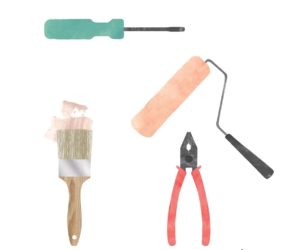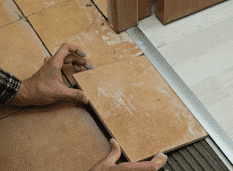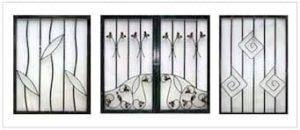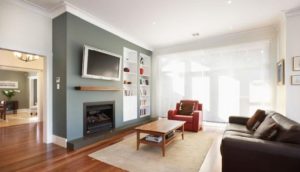If you need to renovate your home, it’s time to get your project management mode on.

You are getting your keys to your new house or you have decided to design and renovate your current house and you are not sure how and where to start? Most of us think our homes could benefit from a renovation, either modest in scale or monumental. No matter the scope, success lies in smart planning.
You need to be clear about why you are renovating before you start and it will provide clarity on all your decisions. But do not fret, here are the guidelines to help you to turn your house into your dream home.
There are fundamentally three options for renovating your home.
The first option is to hire an Architect or Interior Designer to plan, conceptualise and design your house interior space. For this option, you are separating the job of co-ordinating the actual renovation and construction works from the actual creative design of the space that you will be living in. Architects and Interior Designers make spaces functional, safe, and beautiful by determining space requirements and selecting decorative items, such as colours, lighting, and materials. It is a good idea to hire an interior designer if you have invested a lot of money for the house. The main goal of interior designers – make this place attractive and pleasing aesthetically and functionally. Architects and Interior Designer know how to make the house attractive depending on their personalities and their clients’. They can also help in accessing and organizing the materials, even if you do not have time to arrange the house according to your styles and desires because of your work and a busy schedule.
The second option is to find an interior design and renovation company that will manage the entire process from design, construction to moving in. This is the in-between hiring an Architect or Interior Designer and managing your design and build project yourself with multiple contractors. It is where things get murkier and less distinctive. Some may be main contractors or project managers, who included design and client management to their repertoire of services. Most of these companies hire professionally qualified Interior Designers while there are others who will out-source the designing to freelance Interior
Designers. Since designing is out-sourced and the designer who designed your house is different from the sales person who sold you the company’s interior services and the project manager who oversees the building and construction part, you may be dealing with different people for the entire project instead of an individual interior designer.
The third option is to work with contractors and different service providers and self-manage the entire renovation project. One of the biggest challenges that style your home on your own – is for everything to work. If you are not an interior designer, you may find it difficult to make all things work well together. This can eventually lead to costly mistakes that will ultimately cost you a lot of money, unless you are given the right to think. If you have a variety of objects that wallow in the house, it will be difficult to assemble them and it will be difficult to find a suitable tool for solving this problem. On the other hand, the interior designer will face problems almost every day and may have good tips and tricks they use to get the most enjoyable and effective results.
Regardless of which option you chose, knowing and understanding the different steps needed from the planning and design stage to completion for your moving into your dream home is important.

Here are some general guidelines for designing and renovating your home.
1) Design And Planning
Once you have decided to design and renovate your house, it is time to start making a plan. Consider how you live within your home. If you’re renovating for yourself rather than resale, think about how you use the different spaces before you talk to an architect or work on design. Ask yourself these questions:
What time of the day do you use the different rooms?
Who uses them and who will use them in the next five years?
What storage do you need?
Do you have a budding cellist who needs space to practise and store their instrument? A husband who desires a quiet spot to sprawl his newspaper out on a Sunday afternoon? Do teenagers need a chill-out space to watch TV?
Is the bedroom primarily for sleeping, or is it your reading refuge?
Do you use the kitchen island solely to prepare food or do you jostle with children finishing their homework or guests chatting to you while you work?
How do you want your home to flow – open plan or easy to close off? Indoor/outdoor flow or focused internally?
Consideration of how you want to use different rooms will encourage you to think of the comforts of living, such as lighting, speakers and surround sound. From the outset, decide what you want in the way of space saving, electrical points, air-con pipes, false ceiling plan to conceal these pipes and electrical wirings, and so on. Then plan and budget.
Take note of the orientation of your home, where the sun rises and where it sets and determine which rooms you want the light to fill throughout the day. People often like sun in their kitchen and bedrooms in the morning, and afternoon light in their living room. Considering these scenarios gives you a good idea of what you need to do with your floorplan.
Also, you should have a notebook or Excel sheet to make notes on everything from ideas to costing from suppliers to even advice from friends. This will help keep you on track throughout the process. Keep a tape measure and laser tape measure handy so that you can measure every area of your house and also measure furniture when shopping.
It is important to set your budget so that you don’t overspend or get into too big of a loan for your house. If you don’t have a budget limitation, the sky’s the limit!
To start planning, you may visit www.konceptimage.com ideas & tips to see for yourself some home renovation styles, interior design tips and unique interior design ideas. The many things to plan for include paint colour, curtains or blinds for different rooms, what kind of lighting, wardrobes, furniture, electronics, etc.
You may be flipping through Interior Design magazines and websites to identify the design style you desired for your house, it is important to know that the nice pictures you see may not have the same ceiling height, area, length, and width. Keep a tape measure and laser tape measure handy so that you can measure every area of your house and also measure furniture when shopping.
There are hundreds, if not thousands, of contractors in Singapore. Take your time to ask for quotes and advice with your planned requirements. The rule of thumb is to always compare at least 3 quotes. Choose interior designers which professional accreditations and approvals with relevant Authorities. Always check their credentials and past works and ask for references from the owners which they had done works for to ascertain their quality and works.
2) Time Frames
There are three Ps when it comes to a successful renovation: planning, preparation and patience. The third can often be the most challenging because renovations always take longer than anticipated. Establish your time frame by talking to professionals, such as a renovation contractor, interior designer or architect. Be realistic and allow a contingency time frame. In the industry, there is a rule of thumb that if you are occupying the property during renovations, you can expect it to take 50-75 percent more time than if you vacated the property.
3) Cost And Budgeting
Unless you are rich in cash, do not spend more than the property’s resale value. Figure out what you can afford. Here’s how:
Work out your maximum spend. Overcapitalising is an easy mistake. Your investment will depend on a few factors:
a) The condition of your home.
b) The potential resale value of your property – even if you’re not planning to sell, it gives you an understanding of the local market and prevents overcapitalising.
c) How much you paid for the house that you are renovating. Consider its value. What are comparative homes in your area selling for? This will give you an indication of how much you can spend and reclaim when you sell. Different rules of thumb are applied to the percentage you should spend on renovating but it should be based on what you paid for the property and its current condition – if you paid $600,000, but other houses in your street of a similar size are selling for $800,000, you could spend $100,000 or more (depending on the profit you want to make on resale). But if you paid $790,000 for it, you’d probably be wise not to spend even $30,000.
Decide what you want to achieve. Have a list of all the things you could do in your renovation. Next to them, note whether you think they are Important to Have, Nice to Have or Unnecessary. This will help you prioritise and plan your budget.
Think about staging it. If it looks like you are stretching your budget too far, consider renovating in stages. Make a priority list and work your way through it. Anything that improves your quality of life – such as air conditioning or space saving beds should take priority over changes done purely for aesthetics.
Break it down. Once you’ve determined your amount to spend, you should designate funds to various parts of the renovation, such as bathroom, kitchen, bedrooms and exterior. Designating individual budgets for each space helps you keep a handle on finances and stops you from blowing your budget.
4) Start Of Renovation, Demolition And Hacking Works
If you’re planning to restructure the house, have your contractor check with the relevant Authority (HDB or BCA) whether your desired changes are permitted. If you are living in a condominium, you will need to seek approval from its management before you start your renovation works. Depending on the scope of your renovations, you may also need to contact the Management Corporation Strata Title in charge of your condominium. Experienced contractors will be able to advise you based on their experience on what can or cannot be done.
If you are renovating your HDB flat, be sure that your interior design company or contractor is listed as an approved renovator with HDB. Do note that all demolition and hacking of walls (be it partial or complete) require HDB’s prior written approval. Do not instruct workers or any person to carry out demolition/hacking works that have not been approved by HDB in writing and make sure your appointed design house or contractor complies strictly with the permitted time stipulated by HDB so as not to inconvenience your neighbours.
It’s important to remind contractors to dispose of waste in the appropriate designated areas for waste disposal.
5) Electricity Points, Plumbing And Air Conditioner Trunking

You need to plan the positions of electrical points, water points and pipes, and air-conditioning piping and trunking early as this can affect other aspects of the renovation especially if you plan to install false ceilings and partitions. The air-conditioner units can be installed later, but trunking should be planned and done in advance if possible.
Do give consideration to your choice of water heater, whether you want a storage tank heater which will takes up more space, electric heater or gas heater. Have your electrical, bathroom, and kitchen accessories ready when the electrician and plumber come so they can help to fix and install these items for you.
6) Masonry Works And Flooring

Masonry may sound alien and to most contractors they called it wet work. Masonry is anything involving cement. Think building shower kerbs, cabinet bases and tiling floors/walls.
Some of the masonry works includes building kerbs are at the main entrance door, kitchen entrance door, and the toilet and shower area. It also includes cement concrete bases for kitchen cabinet, refrigerator, and washing machine. If you are laying new tiles for your bathrooms, you need to make sure that the floorings have some gradients for better flow of waste water. Different flooring materials cost differently so it will be wise to consult a few suppliers and interior design companies for comparative pricings.
7) Windows Grills
Window grills are the decorative bars that are placed in between the panes of your window to give it a unique look, or match the aesthetic with other windows. Different window manufacturers offer plenty of choices when it comes to grills but ultimately it is up to you decide on the layout, style, and how the grills will look with the other windows in your house.

There are different types of window grills, from the invisible to European art design, to match different home designs. Here are the tips for choosing the right window grills.
a) Choosing The Right Material
The choice is to choose the best material that suites your preference and taste. Are you more concerned about security or the artistic look of the window grille design? If security is the upmost concern, aluminium or stainless steel window grille would serve its function. If you are looking for design beauty, then you can go for wooden grills.
Aluminium window grills main advantage will be its strength as it is resistant to sticking warping when subject to the elements. It neither absorbs rots, water or rusts. Wrought iron is very flexible and durable metal. It may be transform into various curvaceous shapes well as geometrical and abstract patterns such as moons, stars, leaves and etc. as. The grills are utilized on windows which will definitely boost the appeal of your window. There is a variety of designs in the market, if you are uncertain, you can choose to customize your own grill designs! Wrought iron is able to blend elegance with functionality to the theme of your flat.
As technology advances, many young family not only consider the safety aspect of daily living. sophistication, aesthetically beauty is just or more important than safety. The Invisible Grille is invented not only to serve as a safety and security system. It also improves the aesthetic part of it as it does not block the view. Apart from that, invisible window grilles doesn’t affect the overall façade as it visually seamless from afar.
b) Safety
With real life accidents of domestic workers and kids falling from high buildings, safety consideration to prevent fall from height should be seriously considered if there are kids and infants at home. The material that you choose should be strong and the design should be such that you should be able to operate the window with ease and in the same time spaces between bars should be close enough so that children and adults cannot pass through.
c) The colour That You Would Like
Most grilles come in metallic colour or powder coated colour. In order to match your window with the grilles you will need to ensure that they are of the same colour. However, mostly installed window grilles in Singapore are aluminium. Therefore the two mentioned colours are your best shot. However if you wish to install those made from wrought iron there are many colours that you can choose from. Always ensure the colours of your grilles match those of your windows.
8) Painting And Wallpaper
If you are deciding how your walls looks and finishes should be, you can choose whether to use paint or wallpaper. Both can create an absolutely fabulous look within the home depending on how you choose to use them.
Paint is the most popular wall treatment and has been for many years because it is the cheapest and easiest way to give a room an instant makeover. It can be used to draw attention to a feature, or to disguise a feature should it become necessary. You also need much less preparation time for paint than you do for wallpaper and it can hide walls that are in poor condition, while wallpaper exaggerates any wall imperfections. Paint is also more versatile than wallpaper – for the feeling of a light, airy room, or a bigger room, paint is usually necessary.
There are two basic types of paint – water based and oil based. Water based paints are washable and dry quickly. Oil based paints do take longer to dry but they are very rich in colour and are durable. Both oil and water based paints are available in a range of finishes from matte to very high gloss.
However, there are disadvantages to paint as well. Oil based paint especially, is slow to dry and needs a long drying time between coats. It also needs to be applied by a professional as it has a tendency to run, curtain and so forth. Also, the higher the oil content in the paint, the less resistant it is to heat.

If you want to paint different patterns for different walls, you can have different wall colours for each room or each wall – it’s up to your imagination.
Wallpaper may be harder to do than painting is, but it will last for a good deal longer than paint will. In fact, many modern wallpapers will last for ten to fifteen years, whereas, repainting often has to be done as often as every couple of years, depending on your household. Wallpaper can last five times longer than paint under normal conditions, making it a very economical choice. Over time, you can save over 30 percent of your repainting costs, simply by choosing wallpaper.
Wallpaper is unmatched in the aesthetic value that it brings to a room. It adds warmth, character, and beauty, and can be used to create an astonishing variety of effects. It changes the entire look and feel of a room. Some effects that you can get with wallpaper include texture, paint it yourself wallpaper, custom wallpaper that has been printed with a pattern of your choosing, a natural feel, leather look, timber look, and much more. These are effects that simply cannot be replicated with paint.
However, there are disadvantages to wallpaper as well. In humid conditions, the glue may loosen and can actually cause the wallpaper to peel from the wall. It is also easily soiled and damaged. Over time it can be nearly impossible to match the colour or pattern of your wallpaper should it become damaged and need replacing. This can be overcome by keeping a few spare rolls when you first wallpaper but be aware that the wallpaper already on the walls may look faded in comparison to the new rolls thanks to fading by the sun over time. Wallpaper is also costly to replace.
Read Spacekoncept.com shared tips on how different room colours can affect your mood and productivity.
One important thing you need to know is to ensure the painters lay cardboard protection on the floor area so that your new floor does not get paint all over it. If unfortunately paint gets onto your floor, just be polite and ask the painter to help clean up.
9) Carpentry Works

Carpentry work can be done for items like kitchen cabinets, wardrobes, TV consoles, doors, feature walls, bed frames, false ceilings, and different kinds of tables and cabinets.
Explore the different types of wooden material as well as laminates used for the construction of your wooden structures. Pay particular to differences between MDF (Medium Density Fibreboard), solid ply, or solid teak timbers. Choose the right laminates based on your budget as prices differs for different brands, thickness and qualities of the laminates.
MDF is generally cheaper than plywood and the surface of MDF is very smooth and because it’s so smooth the surface is great for painting. Also because of its smoothness, MDF is a great substrate for veneer. MDF is also very consistent throughout, so cut edges appear smooth and won’t have voids or splinters. Because of the smooth edges, you can use a router to create decorative edges.
Do note that MDF is basically glorified particle board and just like particle board, MDF will soak up water and other liquids like a sponge and swell unless it’s very well sealed on all sides and edges with primer, paint, or another sealing product. Because it consists of such fine particles, MDF doesn’t hold screws very well, and it’s very easy to strip the screw holes.
Also MDF can’t be stained. Not only does it soak up stain like a sponge, but also because there’s no wood grain on MDF, it looks awful when it’s stained.
Plywood is also an engineered wood product that is made by pressing and binding sheets of wood veneer together into one solid piece. Plywood comes not only in different thicknesses, but also in different grades, so you can choose the right one for your project. Lower grades are used in construction of houses for subfloors and such. Obviously these types of plywood don’t need to look pretty since they’ll be covered up.
The higher grades of plywood (stain grade, cabinet grade, etc.) are much prettier and smoother. They have consistent wood grain showing, and generally lack knot holes or other major imperfections. And cabinet grade plywood is always sanded very smoothly on the surface. You can also find plywood in various wood species, like oak, or maple, or pretty much anything else, so that you can get exact look you want for your project.
Plywood consists of layers of wood veneer with the grain on each layer running a different direction, making it a very strong building material, less susceptible to water damage than MDF, and won’t soak up water and swell as quickly or easily as MDF does.
It is also stainable, which makes it perfect for kitchen cabinets, table tops, and other projects where you want a large stained wood surface. It holds screws very tightly since the varying grains of wood on each layer give the screws something to hold onto.
Do note that plywood is more expensive than MDF. And obviously, the higher the grade, and the more special the species of wood, the more expensive it gets. Because of the layers that show on the edge, you have to finish off the edges somehow. This can be done with iron-on edge banding or with pieces of lumber or decorative moulding.
Plywood will often splinter on the edges when cut, so it’s harder to get a smooth cut with plywood than it is with MDF and it is more difficult to cut detailed designs into plywood (scrolled, scalloped, etc.) because the edges will splinter, and then you’re left with edges that show layers and might possibly have voids in some places.
So if you are comparing different quotes from various interior design companies or renovation contractors, look carefully at the type of materials the carpenters are quoting you.
Also, try negotiating for a better price if using the same material and design for the whole house – usually material is cheaper when ordered in bulk.
10) Cleaning Up
As a final step after all the heavy duty work is over, you’ll need a few people to help with disposal of renovation debris, and to do some general cleaning as well as a chemical wash. Your interior design company or renovation contractor should include this in their agreement contract and done before handling the finished work to you for move in.
11) Moving in Of Furniture And Electronics
Once your house is done with chemical cleaning and handled over to you, do a walk through with your interior design company or renovation contractor to inspect the work and quality before taking over. If you are happy with the work, the furniture and electronics can move in. This is always the last step to avoid unnecessary damage to these precious items during renovation. And yes, it’s time for you to move in, too!
The information here serves as a guideline and there is definitely much more to learn along the way. Hope these tips are useful to you and, at the end of the day, what’s most important is to have a comfortable home to stay in.
Bear with the renovation process for a few months and live in comfort with a great sense of achievement.
If you need more help and guidance in renovating your home, feel free to reach out to the guys at https://wwwkonceptimage.com, the best interiorr designer in Singapore.
